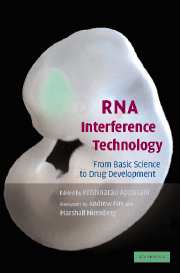Book contents
- Frontmatter
- Contents
- Foreword by Andrew Fire
- Foreword by Marshall Nirenberg
- List of Contributors
- Introduction
- Section one Basic RNAi, siRNA, microRNAs and gene-silencing mechanisms
- 1 RNAi beginnings, Overview of the pathway in C. elegans
- 2 Dicer in RNAi: Its roles in vivo and utility in vitro
- 3 Genes required for RNA interference
- 4 MicroRNAs: A small contribution from worms
- 5 miRNAs in the brain and the application of RNAi to neurons
- Section two Design, synthesis of siRNAs
- Section three Vector development and in vivo, in vitro and in ovo delivery methods
- Section four Gene silencing in model organisms
- Section five Drug target validation
- Section six Therapeutic and drug development
- Section seven High-throughput genome-wide RNAi analysis
- Index
- Plate section
- References
4 - MicroRNAs: A small contribution from worms
Published online by Cambridge University Press: 31 July 2009
- Frontmatter
- Contents
- Foreword by Andrew Fire
- Foreword by Marshall Nirenberg
- List of Contributors
- Introduction
- Section one Basic RNAi, siRNA, microRNAs and gene-silencing mechanisms
- 1 RNAi beginnings, Overview of the pathway in C. elegans
- 2 Dicer in RNAi: Its roles in vivo and utility in vitro
- 3 Genes required for RNA interference
- 4 MicroRNAs: A small contribution from worms
- 5 miRNAs in the brain and the application of RNAi to neurons
- Section two Design, synthesis of siRNAs
- Section three Vector development and in vivo, in vitro and in ovo delivery methods
- Section four Gene silencing in model organisms
- Section five Drug target validation
- Section six Therapeutic and drug development
- Section seven High-throughput genome-wide RNAi analysis
- Index
- Plate section
- References
Summary
Introduction
The 2002 Nobel Prize for Medicine was awarded to Sydney Brenner, Robert Horvitz and John Sulston for their seminal work in establishing the nematode Caenorhabditis elegans as a model genetic organism for studying development and behavior. One of the most sensational discoveries to emerge from C. elegans is the identification of tiny, non-coding RNA genes that regulate development. The original report of a 22 nucleotide (nt) RNA essential for controlling temporal patterning in the worm was unprecedented. Seven years passed before another 22-nt RNA gene was found, once again through genetic studies of developmental timing in C. elegans. This second tiny RNA gene turned out not to be a worm oddity, but instead it was shown to be expressed in most animal species. Thus, the general existence of 22-nt RNA genes was established and the hunt for additional RNAs of this type intensified. Hundreds of ∼22-nt RNA genes have now been uncovered in plants and animals. It is not a coincidence that the tiny size of these endogenous RNAs, called microRNAs (miRNAs), is similar to that of the small interfering RNAs (siRNAs) that direct RNA interference (RNAi); common cellular factors and mechanisms participate in the expression and function of these ∼22-nt RNAs. This chapter focuses on how the discovery of 22-nt RNA genes in C. elegans revealed the broad existence of miRNAs and how the regulation of gene expression by miRNAs compares to RNAi.
- Type
- Chapter
- Information
- RNA Interference TechnologyFrom Basic Science to Drug Development, pp. 69 - 83Publisher: Cambridge University PressPrint publication year: 2005



